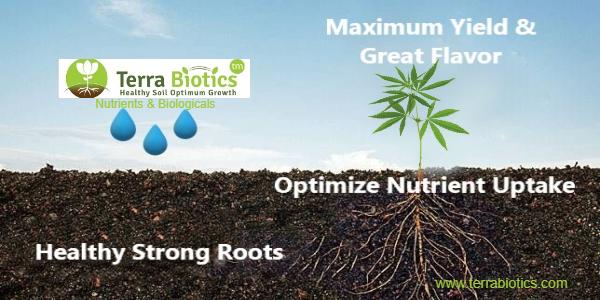Healthy roots make all the difference

Ensure a great flavorful harvest with higher yield from the moment you plant your crops by first focusing on their root health.
Why Your Plants’ Root Health Is So Important
Roots are your plants’ lifeline in many ways. If you grow in soil, roots securely ground your plants in the soil. In any grow setup, they’re how the plant takes nutrients into its stalk, stems and leaves. These nutrients are the building blocks of life. Without them, a plant cannot produce chlorophyll, grow or develop its flowers.
Picture your plants’ roots as straws the plant uses to suck up nutrients from their rhizosphere. Nutrients, like phosphorus and potassium, ensure crop development through the grow cycle. Thicker roots can suck up more nutrients at once, while longer roots can reach further into the plant’s rhizosphere to make use of all that’s present in its soil or hydro solution.
However, roots are more than just nutrient straws. They also condition the plant’s rhizosphere by secreting compounds that interact with the microorganisms present in the environment and antibiotics that kill nematodes and parasites that can destroy roots. The secretions make microorganisms more effective at their jobs, which include protecting the plant from disease and creating space for new roots to develop by eating dead root matter. This ultimately strengthens the plant by increasing its capacity to take up nutrients.
Beneficial microbes and roots have a symbiotic relationship. They interact with each other and crops also benefit from the presence of beneficial bacteria and fungi. In addition to eating dead root matter and increasing root reach, beneficial microbes are hard at work in the root zone performing the following tasks:
- Maintaining the correct pH in the rhizosphere
- Making nutrients more bioavailable to the crop by breaking them into digestible forms
- Secreting growth and bloom cofactors into the crop, boosting its essential oil production
- Establishing and maintaining a balanced rhizosphere
- Increasing nutrient transportation to the plant
If your roots aren’t healthy, then your crops aren’t healthy. And one of the most effective ways to keep your roots healthy is to use beneficial microbes, i.e., nature’s invisible army, as part of your grow system. Roots set the tone for the plant’s entire health status, and when they’re dying or underperforming or infected with a disease, so too is the rest of the plant.
What Do Healthy Plant Roots Look Like?
You know how you can tell a plant is healthy by touching and looking at it? When you’re in the grocery store picking produce, you sort through the different pieces to find the ones that feel solid, ripe and ready to eat. You don’t take the ones that are too soft or discolored — rather, you take the ones that look and feel healthy.
Recognizing healthy plant roots is not much different. Healthy root zones are densely clustered, but you should be able to see every individual root strand. Healthy roots are thick and feel robust between your fingers, not wimpy. They’re muscular and built to work.
The key to repairing roots and sustaining healthy growth is using a plant root stimulator that delivers an army of beneficial bacteria and reinforcements your root zone’s need to stay safe and healthy.
How Beneficial Bacteria Helps Plants Fight Off Pathogens And Pests
Soil microorganisms help plants fight off pathogens by teaching them how to respond to the harmful bacteria when an infection occurs. Pathogens include those found in various fungi species, viruses and nematodes.
Beneficial bacteria also plays the role of vaccine for plants. This is as true for plants that have never encountered harmful pathogens as it is for plants facing an infection.
A recent study published by The Plant Journal examined an experiment conducted to see how well bacillus subtilis inoculates plants against harmful pathogens. Two groups of plants were exposed to pseudomonas syringae, a harmful pathogen that infects many different species. For one group, bacillus subtilis was added to plants’ soil. This group produced abscisic acid that closed its stomata — the pores in plants’ roots and other parts of the plant — to block out the disease-causing bacteria. Among the plants treated with bacillus subtilis, 43 percent of stomata were still open three hours after treatment, compared with 56 percent in the control group.
Root Nutrients Your Crops Need
Your crops need a variety of nutrients to grow strong roots. Phosphorus and potassium are necessary for sustained root development. Living Stone Organics provides crops with the beneficial bacteria that helps them take in more nutrients and make more efficient use of them.
Terra Biotics's Living Stone Organics product line includes the macronutrients, micronutrients, bacteria, fungi, and biologicals to grow a healthy soil food web and strong healthy root system.
Building Your healthy Root Foundation Pays Off
That’s really the basis of it all — when you make it a priority to build and maintain strong, healthy roots, your efforts will pay off later in the form of a big, healthy harvest.
Also in News

Why Healthy Soil is Necessary to Grow Bigger, and Healthier Crops


